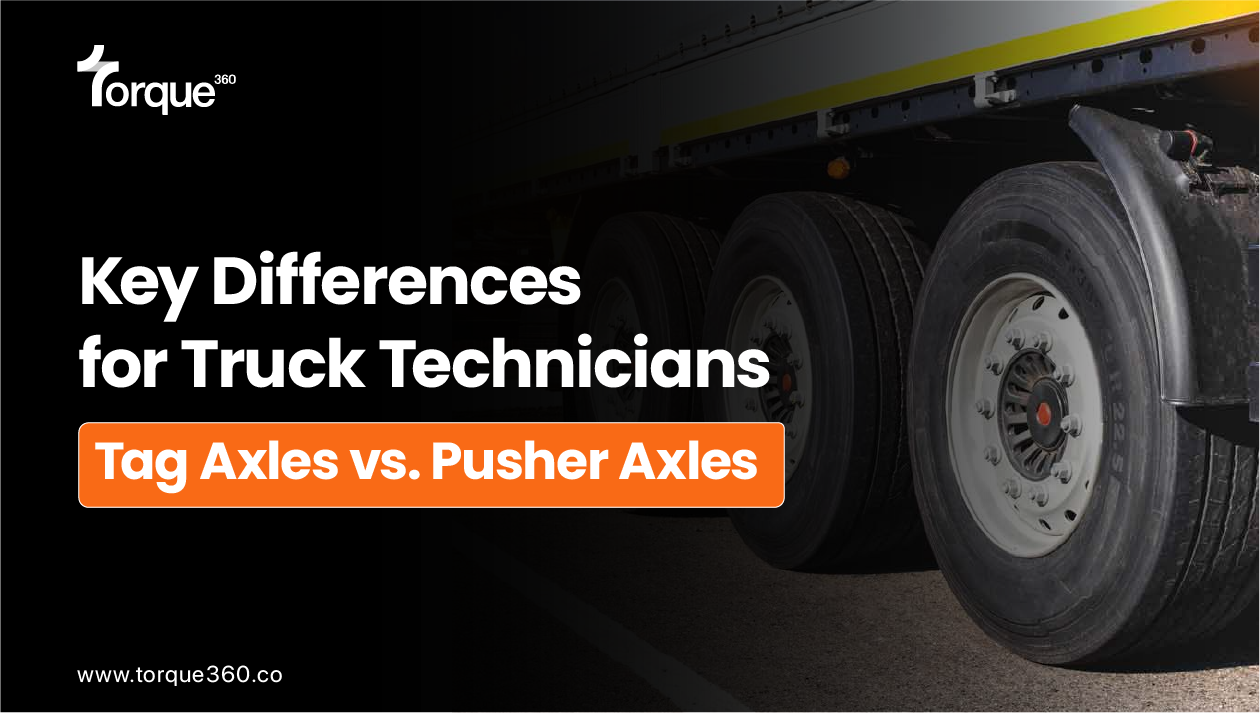When it comes to heavy-duty truck repair, understanding the different components that keep these machines running smoothly is essential.
Among these components, axles play a vital role in ensuring stability, load distribution, and overall performance. Tag axles vs pusher axles are two auxiliary axle types commonly used in the trucking industry.
But how do they differ, and how does this impact truck repair and maintenance? Let’s get into the details.
What is a Tag Axle?
A tag axle, also known as a trailing axle, is positioned behind the truck’s main drive axles.
Function
Its primary function is to help distribute the truck’s weight more evenly, taking pressure off the rear drive axles when the vehicle is loaded.
Purpose
This improves traction, minimizes tire wear, and enhances the truck’s stability.
What makes tag axles unique?
What makes tag axles unique is their versatility. They can be either stationary or liftable. When the truck is empty, the tag axle can be lifted, allowing for greater maneuverability and a tighter turning radius. This is especially useful in situations where trucks need to navigate tight spaces or make sharp turns, such as in city deliveries or waste collection.
What is a Pusher Axle?
A pusher axle, or lead axle, is positioned in front of the truck’s drive axles.
Function
Pusher axles are primarily designed to increase the vehicle’s payload capacity, providing extra stability when carrying heavy loads.
Purpose
By adding additional weight-bearing capacity in the front, pusher axles help evenly distribute the weight across the truck, especially during turns.
What makes pusher axles unique?
Pusher axles are often found on vehicles such as dump trucks, concrete mixers, or any other “severe duty” trucks that frequently carry heavy loads. Like tag axles, pusher axles can also be either stationary or liftable, depending on the specific needs of the truck and the load it’s carrying.
Tag Axles vs. Pusher Axles: Key Differences
Both tag and pusher axles serve a similar function—providing additional support to the drive axles—but they differ in placement, purpose, and ideal applications:
Placement: Tag axles are located behind the drive axles, while pusher axles are positioned in front.
Purpose: Tag axles mainly assist with weight distribution, reducing strain on the rear drive axles, whereas pusher axles help increase the truck’s payload capacity and provide stability for heavy loads.
Maneuverability: Tag axles can be lifted when not in use, offering better maneuverability, especially in tight spaces. Pusher axles, however, remain stationary, offering added weight support and stability during heavy loads.
Common Applications: Tag axles are often found on long-haul trucks or waste management vehicles, while pusher axles are typically used in heavy-duty vehicles like dump trucks and concrete mixers.
When to Use a Tag Axle
Tag axles are ideal for situations where the truck’s weight fluctuates frequently.
For Example
Trucks that carry heavy loads one day and are empty the next benefit from tag axles. By lifting the tag axle when the truck is empty, the driver can enjoy better maneuverability. Common examples of trucks that use tag axles are long-haul tractor-trailers and garbage trucks.
When to Use a Pusher Axle
Pusher axles come into play when the truck is carrying its heaviest loads, such as dump trucks or concrete mixers. The added axle in the front helps support the increased weight, preventing overloading of the tires and providing additional stability during sharp turns.
Maintenance Tips for Tag and Pusher Axles
Maintaining your truck’s axles is crucial for ensuring safety and prolonging the vehicle’s lifespan. Whether you’re working with tag axles or pusher axles, here are some tips for keeping these components in good shape:
Regular Inspection: Always check the tires, brakes, and suspension components for wear and tear.
Lubrication: Keep the axle bearings and hubs well-lubricated to prevent overheating and premature wear.
Tighten Fasteners: Ensure that all bolts and fasteners are tightened to the proper torque specifications.
Check for Play: Any unusual movement in the axle housing could indicate worn bearings or loose bolts, requiring immediate attention.
Choosing Between Tag and Pusher Axles
When selecting the right axle type for your truck, consider the weight distribution, load requirements, and maneuverability. Tag axles offer better maneuverability and weight distribution for fluctuating loads, while pusher axles provide greater stability and capacity for heavier, more consistent loads.
If you’re in the business of truck repairs, understanding the nuances of tag axles vs. pusher axles will allow you to better diagnose issues and provide tailored solutions for your truck repair customers.
Whether you’re repairing tag axles for a long-haul truck or pusher axles for a dump truck, it’s essential to ensure these auxiliary components are functioning properly to avoid costly breakdowns and accidents.
Using Labor Guides for Axle Repairs
When it comes to tag and pusher axles, one of the challenges in the repair and maintenance process is accurately estimating the time and labor required for the job. This is where automotive labor time guides come into play.
Labor time guides are industry-standard references that estimate the average time it takes to perform specific repairs or maintenance tasks on vehicles, including heavy-duty trucks. They take into account the complexity of the repair and the type of vehicle being worked on.
For Example
Replacing or maintaining a tag or pusher axle on a truck requires specialized knowledge and tools, and these guides help shop owners and technicians predict the time and effort needed for such tasks.
Maximize Efficiency with Labor Guides
Whether you’re working on tag axles vs pusher axles, using labor time guides is essential for streamlining the repair process. They provide a consistent framework for estimating repair times and improving shop efficiency.
With the integration in software like Torque360, you can combine these guides with real-world data, enhancing your ability to provide accurate quotes and manage your shop’s workflow effectively.
Conclusion
While both tag and pusher axles serve as auxiliary axles that support the drive axles, their differences in placement and function make them suited for different types of vehicles and applications.
Tag axles help with weight distribution and maneuverability, while pusher axles provide stability and additional capacity for heavy loads. For truck repair shop owners and technicians, understanding these differences is crucial for ensuring proper maintenance and repair.
As you continue to work on heavy-duty vehicles, don’t forget to incorporate modern truck repair shop software to streamline your processes, from scheduling to inventory management.
To learn about the key features of truck repair software, click here!





